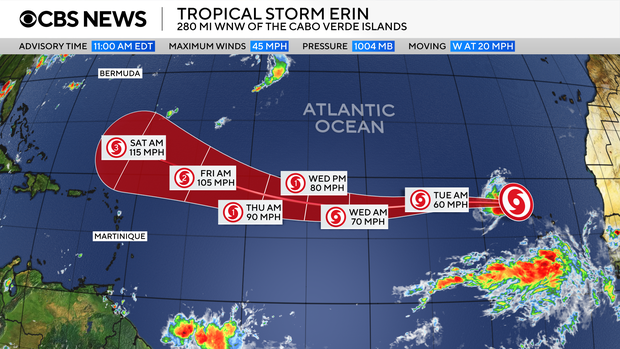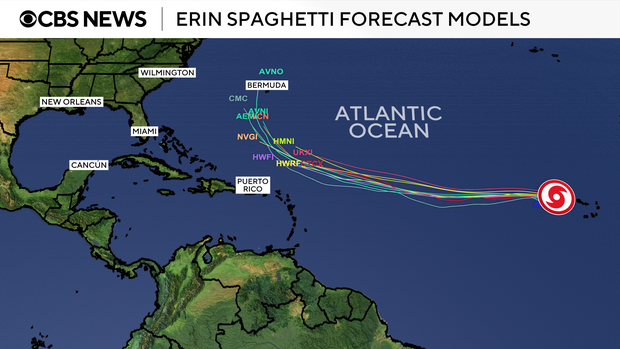Tropical Storm Erin formed in the eastern Atlantic Ocean on Monday, forecasters said. The storm could strengthen to become the Atlantic’s first hurricane of the season.
The storm formed just west of the Cabo Verde islands off the western coast of Africa, the U.S. National Hurricane Center in Miami said. Erin was expected to move west. Early models showed that the storm was expected to strengthen into a major hurricane by the time it nears the Caribbean islands toward the end of the week. It doesn’t pose an immediate threat to the U.S.
Maps show Tropical Storm Erin’s projected path
CBS
CBS
As of 11 a.m. EDT, the center of Erin was located about 2,305 miles east of the northern Leeward Islands in the West Indies with maximum sustained winds of 45 mph.
There’s uncertainty around where Erin goes after this week, but most models show the storm pivoting to the northwest and north, CBS News Miami meteorologist Shane Hinton reported.
Erin is the fifth named storm to develop during the Atlantic hurricane season, which started just over two months ago. Last week, Tropical Storm Dexter formed in the western Atlantic but didn’t pose a threat to land. In early July, Tropical Storm Chantal made landfall on the Carolina coast, bringing deadly flooding to the region.
The Atlantic hurricane season started in June and runs through November, with its peak months being August, September and October. The Pacific Ocean has already seen six hurricanes this year, including Hurricane Henriette, which was located well north of the Hawaiian Islands on Monday and not expected to hit land.
The National Weather Service predicted an above-normal season for the Atlantic basin this year with an expected number of named storms between 13 and 18, five to nine of which could become hurricanes.
A tropical cyclone becomes a tropical storm when its maximum sustained wind speeds reach at least 39 mph. Hurricanes are more powerful with sustained winds of at least 74 mph. Hurricanes are rated on a scale ranging from Category 1 to Category 5, which is the most severe rating. A storm is considered to be a major hurricane when it reaches Category 3 strength with sustained winds of at least 111 mph.
Nikki Nolan
contributed to this report.




